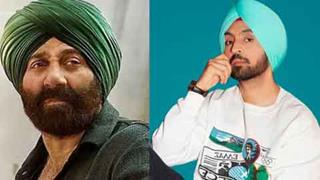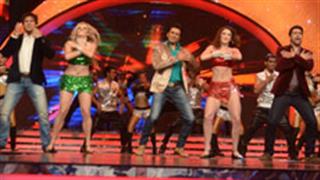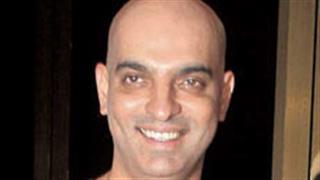In the latest hit Yeh Jawani Hai Diwani Madhuri Dixit's ghagra travels all the way, metaphorically, from Baghdad to Dilli to Agra - what rhyming and what timing!
The question is not about Madhuri Dixit or even about her dance number where she goes step by step with a much younger Ranbir Kapoor. It's the place of item numbers and their provocative lyric that have become de rigour in commercial Hindi films today (and imitated by regional films).

Skin show in item numbers is just a drop in the ocean. The thigh jerks and belly pushes and bust thrusts carry long-lasting impact on the mindset of men, women and children who may wonder what women, and their bodies, are really about.
Vulgar lyrics cloaked with the word 'titillating' have a 30-year-old history. There was a time when a song like hawa mein udhta jaye from Barsaat (1949) was looked upon with disgust and parents would not allow their kids to sing the song. It was considered 'vulgar' because the second line 'mera lall dupatta mulmul ka' was considered very suggestive of you-know-what.

In fact, late B.V. Keskar, independent India's first I & B minister had banned the broadcasting of Hindi film songs over All India Radio. A gentleman named Clifford Dodd understood the potential of Hindi film music. He seized this opportunity and convinced the Ceylon Government (Sri Lanka) to begin a Hindi film song programme. It became an overnight hit.
Vijay Kishore Dubey resigned from AIR to join Radio Ceylon and started Radio Ceylon's Hindi service. For the next 30 years, Radio Ceylon ruled the hearts of Hindi film music lovers. The pinnacle of popularity, undoubtedly, was 'Binaca Geetmala', immortalised by Amin Sayani.
Even Amin Sayani perhaps will shudder to anchor a Hindi music programme today considering the lyrics of most of the songs accompanying the dance numbers. Vulgarity in film songs accompanying the titillating item numbers truly came in full blast with the Choli song-dance trend in the 1990s.
This began with the Choli ke peechhey kya hai in Khalnayak leaving little for imagination. Other rip-offs on similar vein were Main athra baras ki ho gaye meri choli chhoti ho gayee (Dilbar) and Choli Main Tabahee (Khalnayika).
Chad gaya upar re, atariya pe lutan kabutar re from Dalaal (1993) starring Mithun Chakraborty was slaughtered for its raunchy double entendre and suggestive dances.

Cold nights were never the same after Sarkailo Khatiya in Raja Babu was picturised on Karisma Kapoor and Govinda that one critic snubbed 'making love with clothes on' which was not far from the truth.
The Sexy Sexy Sexy mujhe log bole number from Khuddar (1993) featuring Karisma Kapoor triggered a long standing debate in the media about whether it was appropriate to use the word 'sexy' in songs. Under pressure from different sections, the words were changed to 'Baby, Baby'.
David Dhawan and his men pushed the envelope, in utterly bad taste, in Andaaz starring Anil Kapoor, Juhi Chawla and Karishma Kapoor. Just take a look at the lyrics - Malgadi Tu Dhakka Laga, Garam Ho Gya Engine Mera and Khara Hain Khara Hain dar pe tere aashiq khada hain that resulted in a backlash from the public and the media.
Within days of its release its posters were torn down by Shiv Sena and most movie theatres stopped showing the film. There was a huge uproar which in turn led to the mega success of Hum Aapke Hain Kaun released a few months later that marked Bollywood's return to clean family fun.

Looking back, all this is kindergarten stuff when placed against the vulgar body language of Kareena Kapoor in her Halkat Jawaani number. Few are aware that the word 'halkat' is a cuss word not used in public space by decent people.
But who defines 'decency' these days? Not the lyricists, the music composers, the producers, the directors, the singers and the dancers. While critics howl, they laugh all the way to the bank.
After her `Halkat Jawaani` number, Kareena went one better to perform Fevicol Se for Dabangg 2. The lyrics sung to the beat of fast music and pelvic thrusts invite the 'prince' to 'come let me show you heaven. I am a piece of tandoori chicken, down me with alcohol, if you will.'

The lyrics of a song in I Don't Love You that went 'Ishq Ki Maa Ki' sung by Mika Singh had to be changed after the Central Board of Film Certification (CBFC) raised objections to the lyrics. The offending word, which featured in the movie's trailer, was changed slightly to 'Ishq Ki Naa Ki'.
Today, no one seems to raise an eyebrow when a leading lady exclusively performs a sexy item number like Chikni Chameli wrapped tightly in a knee-length sari draped in Maharashtrian Koli style with a tiny knotted choli to boot that allows your imagination run riot.

The chikni chameli number roughly translates as `My beauty is the match that lights up your weed', before adding this little gem: 'My evenings are free to be shared with you; my words suggest the play at hand, break-in to steal the treasures I possess inside'.
One must remember that a top star is an icon for the GenerationY and has a greater impact on them than an item number performed by Mallika Sherawat or Malaika Arora.
`Suggestive lyrics, gyrating moves and pelvic thrusts, along with figure-hugging skimpy outfits are the USP of such attention-grabbing songs. Add to that mix is a hot looking leading actress or an international model, and what you have is a lethal combination of a marketing package that's catered to entice the masses,` says Bindu Suresh Rai, a Dubai-based journalist.

Mithun's song number mirchi re mirchi kamala kar gayee began the trend of equating women with items of food which either the dancer proclaimed herself or some man did in the film.
This went a bit further in Coolie Number One when Govinda and Raveena Tandon danced to the lyrics that spelt out tujhko mirchi lagi to main kya karoon mouthed by both. So there is no gender discrimination here.
Today, we have our our tandoori chickens and jalebi bai replicated by little girls between the age of six and nine performed on the current Indian Idol programme exclusively to unfold very young talent. One of the judges Shreya Ghosal, also sang happily along when a little contestant, a boy, belted out oo la la.

Says choreographer Saroj Khan, `I have seen changes. They are not always for the better. Earlier, there were actors such as Vyjantimala, Waheeda Rahman or Helen.
They looked as if they were made exclusively for dance and their movements were so neat and clean. Now, there's a lot of vulgarity. The only thing people know these days is how to copy. It makes me think: if you cannot get the original steps right, why make a bad copy? Every film has the same type of dance movements.`
In India's Dancing Superstars, another reality show on a parallel channel, a seven-year-old girl performed maala zaaoo de in Lavani style with latkas and jhatkas unimaginable for a girl who ought to play with dolls or do her homework.
Another 13-year old did Purdah Purdah number from Once Upon a Time in Mumbai after having stuffed her chest with cotton under her dress. What are these parents up to?
People also ask, why don't the schools ban the entry of little children in these reality shows where item numbers and the ones who perform these have become role models?

Concerned citizens who want the vulgar item numbers to stop can register an FIR under Sections 292, 293 and 294 of the Indian Penal Code that deals with obscenity at public places. But is a cinema hall or a television screen a 'public place'? Questions remain. Meanwhile they also ask, what's the Censor Board doing?



















